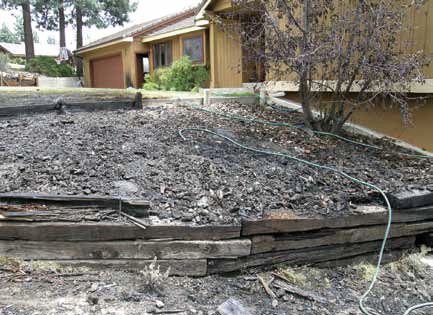Mulch plays an important role in your landscape. Proper mulch application provides benefits to water retention, soil temperature, weed inhibition, and soil erosion. These qualities can help reduce fuel risk in fire prone areas, but also introduces a new combustible material into your landscape. For this reason, it is important to consider the type, location, and quantity of mulch used.

Maintaining noncombustible, ignition–resistant areas immediately adjacent to structures (within 5 ft) is particularly important. Embers often accumulate in these areas, providing an ignition source for combustible materials. Further away from the structure, mulch-covered areas should be separated by noncombustible materials. This is to prevent the mulch, if ignited, from spreading the fire in a continuous manner.
Irrigating wood and bark mulches should not be relied upon to lessen fire hazard. Irrigation does reduce the ignitability of mulches, but water supply and pressure may be limited or unavailable during a wildfire. Furthermore, the dry, hot and windy weather seen during wildfires will dry out the mulch bed well in advance of the flaming front.
Material options
Composted Wood Chips under 3 inches in size, should be applied 2-4 inches deep. This material has low burn characteristics, but may smolder. Smoldering combustion produced by this mulch treatment may not be readily noticeable during a wildfire event and may go undetected by firefighters.
Rice Straw or Coconut Fiber mulches are often the most effective treatment to protect gentle slopes from erosion. Find more information about installing post fire erosion control here.
Shredded Rubber, Pine Needles and Shredded Cedar Bark have among the highest hazardous combustion characteristics and are recommended for use only in areas more than 30 feet from the house. Although shredded rubber is not a natural woody mulch, it is still flammable and will smolder and flame. It should be limited to use under play equipment and more than 30 feet from structures.
Paving Stones, Gravel, and Decomposed Granite are non-combustible and should be used within 5 feet of the home, along pathways, and to segment patches of combustible vegetation.

References
Check out these additional wildfire preparedness resources from UC ANR Fire Network Members and our colleagues!
Mulch flammability